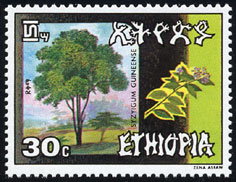Home garden coffee as a repository of epiphyte biodiversity in Ethiopia. 2008. K. Hylander and S. Nemomissa. Frontiers in Ecology and the Environment. 6:524-528.
Nearly all the work that’s been done examining the relationship between shade coffee and biodiversity has taken place in Latin America, so it’s good to see studies like this coming out of Africa.
This study looked at the diversity of epiphytes and bryophytes (mosses, liverworts) in home coffee gardens and forest patches in southwestern Ethiopia near Bonga. People often grow coffee under shade trees in their gardens, and this study not only compared the gardens versus the forest, but also the epiphytes growing on the coffee shrubs and shade trees.
 Six to 27 species of epiphytes were found growing on coffee shrubs in home gardens, and only liverworts were more diverse on forest coffee shrubs. Eleven to 33 species were found on shade trees in home gardens. Overall, epiphyte/bryophyte diversity was higher on forest shade trees, but there was a lot of overlap and many garden shade trees had richer diversity than those in the forest. It was also noted that heavily pruned coffee in more intensively managed farms did not host many epiphytes.
Six to 27 species of epiphytes were found growing on coffee shrubs in home gardens, and only liverworts were more diverse on forest coffee shrubs. Eleven to 33 species were found on shade trees in home gardens. Overall, epiphyte/bryophyte diversity was higher on forest shade trees, but there was a lot of overlap and many garden shade trees had richer diversity than those in the forest. It was also noted that heavily pruned coffee in more intensively managed farms did not host many epiphytes.
The authors concluded that coffee shrubs and shade trees in home gardens are important hosts of epiphytes and bryophytes, helping to preserve the biodiversity of these plants. They also felt that epiphytes and bryophytes likely provide nest material, nest sites, and food sources for birds as has been proven in Latin America. Shaded home coffee gardens also had the added benefit of providing resources such as honey and firewood, and environmental services such as erosion control.
The tree depicted on the stamp, Bicoloured waterberry, Syzygium guineense, is a common canopy tree in the region of Ethiopia examined in this study.
K. Hylander, S. Nemomissa. (2008). Home garden coffee as a repository of epiphyte biodiversity in Ethiopia. Frontiers in Ecology and the Environment, 6 (10), 524-528 DOI: 10.1890/080001
Revised on November 14, 2019

This is good news, certainly. What I'd really like to hear is that the farmers themselves are also benefiting, whether it me economically or health-wise from not being around chemicals and pesticides.
Debbie
http://www.organic-food-and-drink.com
Comments on this entry are closed.